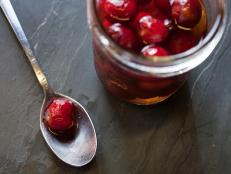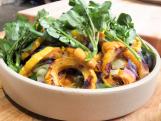Super Food Nerds, Behind the Scenes: The Cherry on Top

2013
Close your eyes and picture “cherry red.” What do you see? I’d wager you’re picturing a color that has been witnessed in a fresh cherry precisely … never. What you are seeing is a maraschino cherry — maraschino red, that is.
Which is odd, because the maraschino we’ve come to know bears only the faintest relation to a real cherry. Today’s maraschino is a preserved fruit of a particularly brutalized sort, the result of chemical brines, artificial dyes and “natural” flavors that would shame even a cosmetic surgeon. The jarred stuff starts with sweet cherries (typically Royal Ann or Rainier); these are saturated with calcium salts, which firms the cherries’ texture while stripping color and flavor. The resulting specimens are then pitted and macerated in sugar syrup. After a month of maceration, the cherries are dipped in red dye, stem and all, and packed in almond-flavored syrup.
The resulting product is indisputably an eye-catching garnish; whether it is an edible foodstuff is debatable. With its impossibly cloying sweetness and synthetic taste, the maraschino is rich in meaning, poor in flavor. But it persists because flavor is beside the point. The maraschino exists as an ornament, a bauble, a visible sign that says, “Now we are treating ourselves.”
Flavor hasn’t always been an afterthought, though. For centuries, before they became a cliche, maraschino cherries were a rare and coveted luxury item. Their distinguished pedigree traces back to 16th-century Dalmatia (a region of modern-day Croatia), where Dominican monks first distilled the wild marasca cherry — a sour variety celebrated for its spicy cinnamon flavor — in a clear liqueur. With time and tinkering — like sweetening with cane sugar and distilling the cherry pits separately (which lent bitter, almond notes) — the monks arrived at the spirit that came to be known as maraschino, still produced in Italy today.

2013
The original maraschino cherries — sour marascas preserved in their own liqueur — are undoubtedly as old as the liqueur itself, and for centuries these ancestral maraschino cherries remained a regional delicacy. Then, early in the 1800s, for reasons lost to history, they caught on like a Cronut among European gastronomes. It wasn’t long before maraschino liqueur and maraschino cherries found their way to the United States. Their arrival coincided with the dawn of the cocktail age, and before long they were widely embraced as a mixer and garnish, respectively. Many now-classic cocktails like the Manhattan, Aviation, Old-Fashioned and Martinez (precursor to the martini) employ maraschino liqueur, or are adorned with the cherries.
Prohibition put an abrupt end to these boozy delights, but it couldn’t kill off Americans’ love for their cherished garnish. Today’s neon-red, candy-sweet, nonalcoholic imitation was forged during those dark days. Ernest Wiegand, a University of Oregon food technologist, labored six long years to come up with the American maraschino, a teetotalled makeover better suited to the ice cream parlor than the public house. And today, nearly 80 years after the repeal of Prohibition, the original maraschinos — those sour cherries preserved in their own liqueur — are nearly forgotten, one of the lost flavors of the golden age of the American cocktail. Meanwhile, Wiegand’s invention continues its reign atop sundaes and cocktails alike, the quintessential garnish and the ultimate emblem of cherriness itself. It is, after all, the cherry on top.
But what of that long-lost original maraschino? Stay tuned next week to find out what happened when I attempted to recreate the once-adored boozy fruit in an all-new edition of Super Food Nerds.
Super Food Nerds is a column written in alternating installments by Rupa (food and beverage editor, culinary staff) and Jonathan (research librarian, same place). Each post will be dedicated to a particular topic — how to DIY something you don’t normally DIY, how to perfect a dish usually taken for granted, plus the best techniques, underlying chemistries and a handful of inexplicable preferences. Basically, if they can overthink it, they’re on it.












